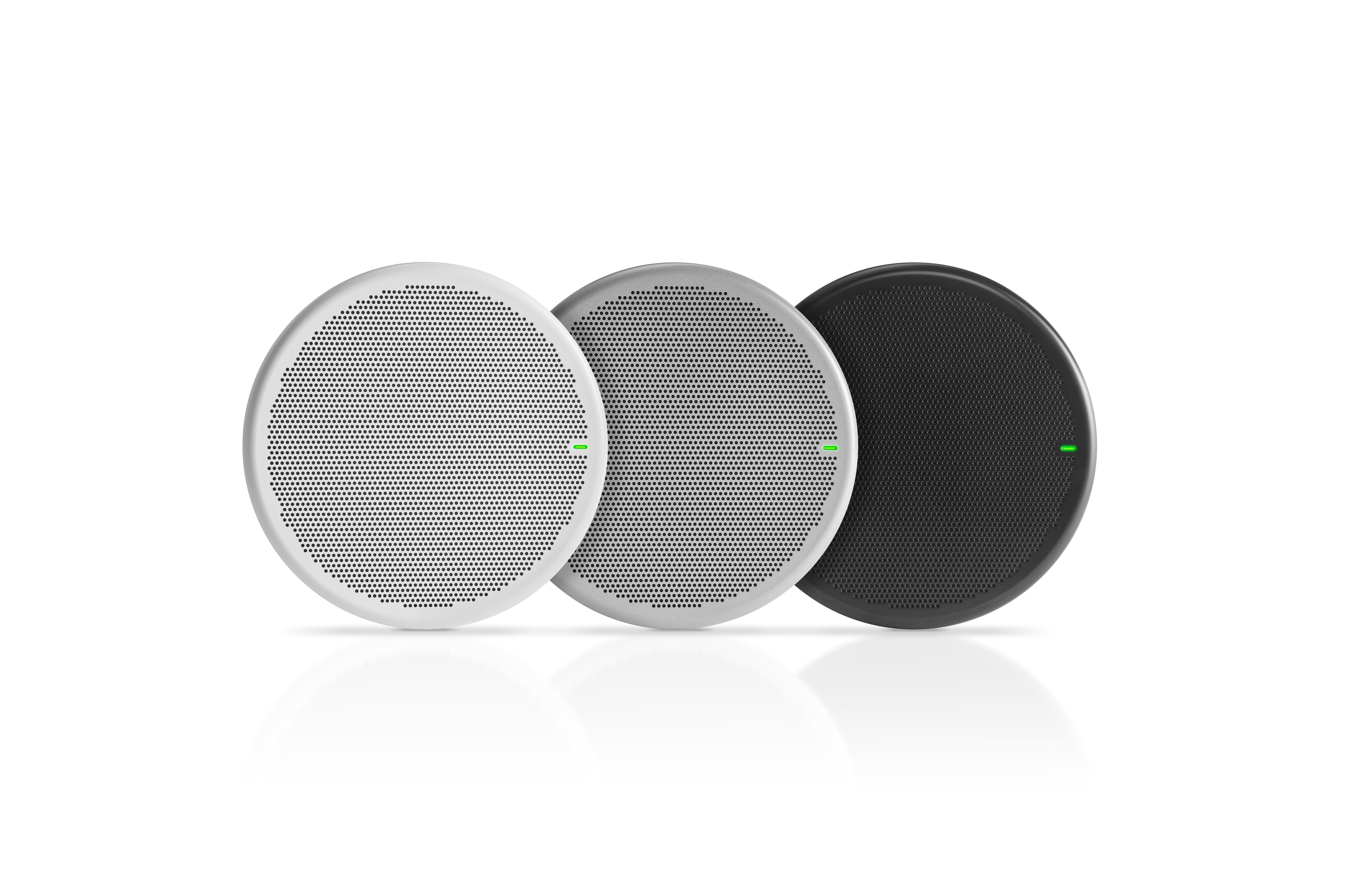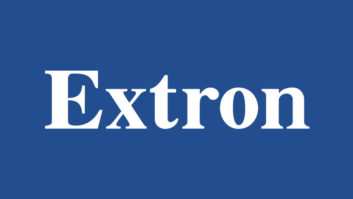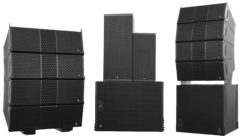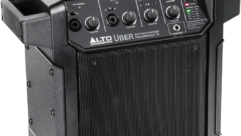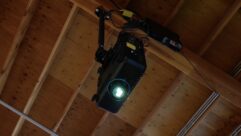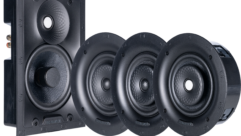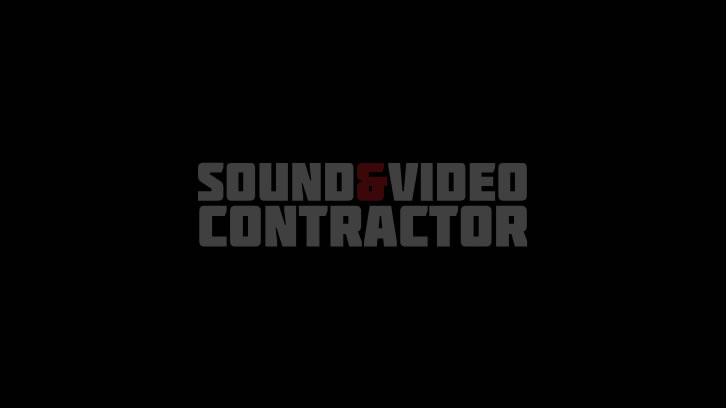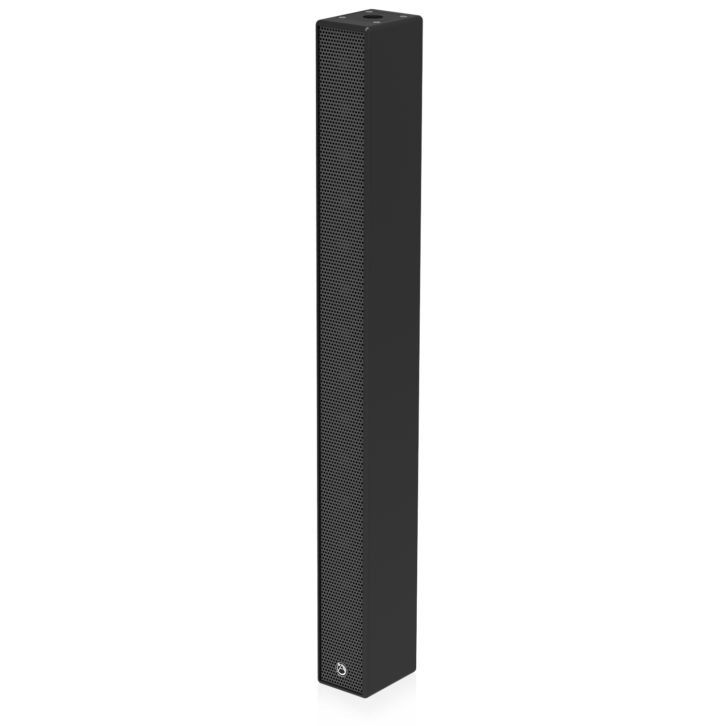
While it’s in the wire, a sound signal is pretty tame and can be manipulated with ease, but after it goes to the speakers, sound becomes a big challenge to handle with room acoustics presenting a wide world of environments with which speaker systems must be matched. Passive and self-powered line arrays were developed to provide the customized solution for each venue and along the way, new mounting systems and more efficient amplifiers have enabled their rise to prominence. The systems surveyed here cover a wide range of sizes and styles but each answers this common call.
 As the first model of the Vergence Group, the Adamson Systems Engineering VGt encloses its sophisticated works inside marine grade birch plywood and allows uncomplicated, one-person Autolock rigging with daisy-chained cabling. A trio of 3in. HF compression drivers team with M140 Kevlar compression units for the HF/MF band while two ND13-S 13in. Kevlar Neodymium drivers produce full-bodied bass. Altogether, this system has a 50Hz-20kHz (+/- 3dB) frequency response with a -6dB directivity of 90×6 degrees. The cabling carries analog audio, power, and network with Milan digital audio and AES70 control data. Available in black, white, or RAL colors on demand, the VGt includes 5-channel Onboard Class-D, SMPS amplification.
As the first model of the Vergence Group, the Adamson Systems Engineering VGt encloses its sophisticated works inside marine grade birch plywood and allows uncomplicated, one-person Autolock rigging with daisy-chained cabling. A trio of 3in. HF compression drivers team with M140 Kevlar compression units for the HF/MF band while two ND13-S 13in. Kevlar Neodymium drivers produce full-bodied bass. Altogether, this system has a 50Hz-20kHz (+/- 3dB) frequency response with a -6dB directivity of 90×6 degrees. The cabling carries analog audio, power, and network with Milan digital audio and AES70 control data. Available in black, white, or RAL colors on demand, the VGt includes 5-channel Onboard Class-D, SMPS amplification.
 The AtlasIED Aimline Series includes column array loudspeakers with digitally steerable and passive models suited for environments where traditional speakers may not provide optimal coverage and where precise directionality is required. The series is designed to perform for long hours in large, open venues with poor acoustics, including those with reflective surfaces. The first two Aimline releases include the ALXD and ALXP. The digitally steerable ALXD column array loudspeaker with Dante includes built-in amplifiers and signal processing in a sevenmodel lineup The Aimline ALXP series are costeffective passive column array loudspeakers in 4, 8, 12, and 16 models.
The AtlasIED Aimline Series includes column array loudspeakers with digitally steerable and passive models suited for environments where traditional speakers may not provide optimal coverage and where precise directionality is required. The series is designed to perform for long hours in large, open venues with poor acoustics, including those with reflective surfaces. The first two Aimline releases include the ALXD and ALXP. The digitally steerable ALXD column array loudspeaker with Dante includes built-in amplifiers and signal processing in a sevenmodel lineup The Aimline ALXP series are costeffective passive column array loudspeakers in 4, 8, 12, and 16 models.
 Versatility and maximum customization are key concepts in the Bose Professional ArenaMatch AM20 DeltaQ array loudspeaker which can be set with any of nine coverage patterns. Module choices include those with 10, 20, or 40-degree vertical coverage and these can be configured to operate with 60, 80, or 100-degree replaceable horizontal waveguides. SPL is not a problem with its 14in. neodymium woofer and six Bose Professional EMB2S titanium-diaphragm neodymium compression drivers. Enclosed with a three-layer stainless steel grille, water-resistant woofer cone coating, industrial polyurethane exterior coating, and molded input cover, the AM20 ArenaMatch is rated for weather-exposed installations.
Versatility and maximum customization are key concepts in the Bose Professional ArenaMatch AM20 DeltaQ array loudspeaker which can be set with any of nine coverage patterns. Module choices include those with 10, 20, or 40-degree vertical coverage and these can be configured to operate with 60, 80, or 100-degree replaceable horizontal waveguides. SPL is not a problem with its 14in. neodymium woofer and six Bose Professional EMB2S titanium-diaphragm neodymium compression drivers. Enclosed with a three-layer stainless steel grille, water-resistant woofer cone coating, industrial polyurethane exterior coating, and molded input cover, the AM20 ArenaMatch is rated for weather-exposed installations.
 Coming out of last year’s InfoComm with a Best in Market award, the Blaze Audio CCA10 has a fixed vertical coverage of 20 degrees and can be flown in vertical arrays of up to 12 units. Its coaxial compression driver with polymer ring-shaped diaphragms covers mid-and high-frequency response from 420Hz to 18kHz. At the bottom end, two high excursion drivers extend coverage down to 52Hz at 4-ohm impedance. Nominal (-6dB) horizontal dispersion covers 160 degrees. The system’s maximum SPL is 130dB and it is designed to be readily bi-amp operated. The tough Polyurea coating provides professional-looking aesthetics while durably protecting all components.
Coming out of last year’s InfoComm with a Best in Market award, the Blaze Audio CCA10 has a fixed vertical coverage of 20 degrees and can be flown in vertical arrays of up to 12 units. Its coaxial compression driver with polymer ring-shaped diaphragms covers mid-and high-frequency response from 420Hz to 18kHz. At the bottom end, two high excursion drivers extend coverage down to 52Hz at 4-ohm impedance. Nominal (-6dB) horizontal dispersion covers 160 degrees. The system’s maximum SPL is 130dB and it is designed to be readily bi-amp operated. The tough Polyurea coating provides professional-looking aesthetics while durably protecting all components.
 Wide frequency response of 70Hz-20kHz and tight control are designed into the DAS Audio EVENT-210A three-way powered line array. Users have a preset selection for the number of units and throw depth through the DAS Easy-DSP on the rear panel. This unit is powered up to 360W peak per channel by a three-channel Class D amplifier. Audio exits the array unit through a DAS M-75 compression driver and cone transducers. The 90-degree horizontal coverage is complemented by adjustable vertical dispersion set on the “quick-rig” professional rigging hardware and it is all enclosed and protected by the birch plywood housing and durable ISO-flex finish.
Wide frequency response of 70Hz-20kHz and tight control are designed into the DAS Audio EVENT-210A three-way powered line array. Users have a preset selection for the number of units and throw depth through the DAS Easy-DSP on the rear panel. This unit is powered up to 360W peak per channel by a three-channel Class D amplifier. Audio exits the array unit through a DAS M-75 compression driver and cone transducers. The 90-degree horizontal coverage is complemented by adjustable vertical dispersion set on the “quick-rig” professional rigging hardware and it is all enclosed and protected by the birch plywood housing and durable ISO-flex finish.
 Ready for permanent installation, the d&b Audiotechnik Ti10L is the install version of the T10. The polyurethane integral hard foam cabinet contains twin 6.5in. drivers and a 1.4in. exit HF compression driver. Its rotatable waveguide with horn and an acoustic lens provide a 90-degree horizontal dispersion down to 600Hz while the HF coverage is 105 degrees. From front impacts, the unit is protected by a metal grill backed by an acoustically transparent foam and the wiring is connected on the rear with two NL4 connectors wired in parallel. The Ti10L is available in special color and IP55- rated weather resistant versions.
Ready for permanent installation, the d&b Audiotechnik Ti10L is the install version of the T10. The polyurethane integral hard foam cabinet contains twin 6.5in. drivers and a 1.4in. exit HF compression driver. Its rotatable waveguide with horn and an acoustic lens provide a 90-degree horizontal dispersion down to 600Hz while the HF coverage is 105 degrees. From front impacts, the unit is protected by a metal grill backed by an acoustically transparent foam and the wiring is connected on the rear with two NL4 connectors wired in parallel. The Ti10L is available in special color and IP55- rated weather resistant versions.
 For medium to larger outdoor events and indoor venues, the EAW NTX210L powered 10in. line array applies Optilogic technology through onboard infrared sensors and accelerometers to allow speakers to communicate and self-optimize through the system. EAW’s Resolution 2 software aids in system design, setup, and prediction in this single app. Built-in Dante networking is backed up with analog capability and XLR connections. The unit’s nominal beamwidth is 90 degrees horizontal by 12 degrees vertical and the operating frequency range is 55Hz18kHz. This emanates from twin 10in. transducers working with compression drivers and produces a maximum SPL of 140dB.
For medium to larger outdoor events and indoor venues, the EAW NTX210L powered 10in. line array applies Optilogic technology through onboard infrared sensors and accelerometers to allow speakers to communicate and self-optimize through the system. EAW’s Resolution 2 software aids in system design, setup, and prediction in this single app. Built-in Dante networking is backed up with analog capability and XLR connections. The unit’s nominal beamwidth is 90 degrees horizontal by 12 degrees vertical and the operating frequency range is 55Hz18kHz. This emanates from twin 10in. transducers working with compression drivers and produces a maximum SPL of 140dB.
 Equipped with an integrated rigging system and housed in an EVCoat finished birch plywood cabinet, the Electro-Voice X2-212/90 12in. vertical line array system features a DVN3125 12in. Neodymium woofer and two 3in. ND6A HF transducers. The small size can accomplish up to 2000W peak passive power handling and a -6dB horizontal coverage angle of 90 degrees. The integrated rigging system is standard issue on all Electro-Voice X-Line Advance loudspeaker systems and X12-125F flying subwoofers. The system produces a -3dB frequency response of 52Hz-19kHz and each unit weighs in at 93lbs.
Equipped with an integrated rigging system and housed in an EVCoat finished birch plywood cabinet, the Electro-Voice X2-212/90 12in. vertical line array system features a DVN3125 12in. Neodymium woofer and two 3in. ND6A HF transducers. The small size can accomplish up to 2000W peak passive power handling and a -6dB horizontal coverage angle of 90 degrees. The integrated rigging system is standard issue on all Electro-Voice X-Line Advance loudspeaker systems and X12-125F flying subwoofers. The system produces a -3dB frequency response of 52Hz-19kHz and each unit weighs in at 93lbs.
 Using the company’s Radiation Boundary Integrator design, the self-powered JBL SRX900 Series array speakers put the HF and LF transducers on a single horn to allow better horizontal coverage without going to a larger enclosure size. Its 2432H3 neodymium magnet compression driver and 3in. titanium diaphragm substantially extend HF response. Onboard DSP features 24-band parametric EQ, 2,000ms of delay and gain control along with the Array Size Compensation (ASC) filter and Throw Distance Compensation (TDC) filter to minimize airimposed sound loss. HARMAN’s new HControl ethernet protocol provides network stability, reduces traffic load, and allows operators to avoid using complex IP addresses. The series consists of the SRX906LA dual 6.5in. powered line speaker, the SRX910LA dual 10in. powered line array element, the SRX918S 18in. subwoofer, and the SRX928S dual 18in. subwoofer.
Using the company’s Radiation Boundary Integrator design, the self-powered JBL SRX900 Series array speakers put the HF and LF transducers on a single horn to allow better horizontal coverage without going to a larger enclosure size. Its 2432H3 neodymium magnet compression driver and 3in. titanium diaphragm substantially extend HF response. Onboard DSP features 24-band parametric EQ, 2,000ms of delay and gain control along with the Array Size Compensation (ASC) filter and Throw Distance Compensation (TDC) filter to minimize airimposed sound loss. HARMAN’s new HControl ethernet protocol provides network stability, reduces traffic load, and allows operators to avoid using complex IP addresses. The series consists of the SRX906LA dual 6.5in. powered line speaker, the SRX910LA dual 10in. powered line array element, the SRX918S 18in. subwoofer, and the SRX928S dual 18in. subwoofer.
 Another array system with big sound in a small footprint is the KGEAR GF42TI, an ultracompact 4×2-inch line array column speaker. The K-Array Pure Array Technology (PAT) allows perfect phase response to be achieved in both the near and far sound fields. Each ABS cabinet houses four 2in. ferrite magnet woofers and an integral transformer that make this model perfect for 70/100V sound systems. When paired with the K-Array GS6 matched subwoofer, these components can output very rich sound. Available in black or white finish, the GF42TI can get up to an SPL of 102dB with a frequency range of 160Hz20kHz (-6dB).
Another array system with big sound in a small footprint is the KGEAR GF42TI, an ultracompact 4×2-inch line array column speaker. The K-Array Pure Array Technology (PAT) allows perfect phase response to be achieved in both the near and far sound fields. Each ABS cabinet houses four 2in. ferrite magnet woofers and an integral transformer that make this model perfect for 70/100V sound systems. When paired with the K-Array GS6 matched subwoofer, these components can output very rich sound. Available in black or white finish, the GF42TI can get up to an SPL of 102dB with a frequency range of 160Hz20kHz (-6dB).
 If users want to dial back the power to cover a somewhat smaller area, the Martin Audio O-Line modular micro line array offers its wide range of architectural compatibility and its ability to reproduce very high frequencies without sidelobes. In simple setups, one O-Line element can be driven by a single amp channel. When used with select iKON amplifiers, independent control and power over each individual enclosure is possible. But small doesn’t mean weak. A 16-cabinet system can get up to 134dB peak SPL and throw to a distance of 130ft. with 85Hz-20kHz (±3dB) frequency response
If users want to dial back the power to cover a somewhat smaller area, the Martin Audio O-Line modular micro line array offers its wide range of architectural compatibility and its ability to reproduce very high frequencies without sidelobes. In simple setups, one O-Line element can be driven by a single amp channel. When used with select iKON amplifiers, independent control and power over each individual enclosure is possible. But small doesn’t mean weak. A 16-cabinet system can get up to 134dB peak SPL and throw to a distance of 130ft. with 85Hz-20kHz (±3dB) frequency response
 A star performer in power-to-size ratio is the Meyer Sound LEOPARD line array and when it is configured with the LEOPARD-M80, 900LFC Compact Low-Frequency Element, and the Galileo GALAXY processor, customization for the specific house is maximized. The original Leopard provides 110-degree horizontal coverage while the Leopard-M80 variant pins down the horizontal coverage to 80 degrees. Along with its Class-D internal amplifiers, the LEOPARD system can be used in Native Mode, a factory setting that allows the arrays to be used right out of the box with minimal processing. Meyer Sound’s QuickFly rigging with captive GuideALinks enables fast splay angle adjustment from 0.5 degrees to 15 degrees. Sometimes the primary challenge in a venue is just the sheer size or depth of the house and in those applications the L-Acoustics K1 three-way active dual 15in. array system has proven itself in the highest profile events. The 90-degree horizontal and 5-degree vertical dispersion cuts straight to the back row with close-up presence. A maximum 149dB SPL applies the long-throw sound with a frequency range of 35Hz-20KHz while its big woofers are teamed with four 6.5in. midrange and three 3in. transducers for wide spectrum response. Four handles are integrated into the cabinet and there is a wide range of inter-enclosure angles from which to choose.
A star performer in power-to-size ratio is the Meyer Sound LEOPARD line array and when it is configured with the LEOPARD-M80, 900LFC Compact Low-Frequency Element, and the Galileo GALAXY processor, customization for the specific house is maximized. The original Leopard provides 110-degree horizontal coverage while the Leopard-M80 variant pins down the horizontal coverage to 80 degrees. Along with its Class-D internal amplifiers, the LEOPARD system can be used in Native Mode, a factory setting that allows the arrays to be used right out of the box with minimal processing. Meyer Sound’s QuickFly rigging with captive GuideALinks enables fast splay angle adjustment from 0.5 degrees to 15 degrees. Sometimes the primary challenge in a venue is just the sheer size or depth of the house and in those applications the L-Acoustics K1 three-way active dual 15in. array system has proven itself in the highest profile events. The 90-degree horizontal and 5-degree vertical dispersion cuts straight to the back row with close-up presence. A maximum 149dB SPL applies the long-throw sound with a frequency range of 35Hz-20KHz while its big woofers are teamed with four 6.5in. midrange and three 3in. transducers for wide spectrum response. Four handles are integrated into the cabinet and there is a wide range of inter-enclosure angles from which to choose.
 Constructed of a reticulated urethane copolymer material and available in black, white, or RAL colors, the NEXO GEO M1025 can be stacked or flown. No tools are required to adjust the horizontal dispersion angle setting to either 80 or 100 degrees using magnetic flanges in the waveguide. The vertical spread angle is set to 25 degrees and the unit may be used with or without its companion sub, the MSUB15. Each enclosure houses a 10in. 8-Ohm long excursion Neodymium driver and a 1.4in. throat driver on a BEA/FEA optimized HR Wavesource. The unit can handle a peak SPL of 136dB and deliver a frequency response of 59Hz to 20kHz. Recommended power for the GEO M1025 is 750W.
Constructed of a reticulated urethane copolymer material and available in black, white, or RAL colors, the NEXO GEO M1025 can be stacked or flown. No tools are required to adjust the horizontal dispersion angle setting to either 80 or 100 degrees using magnetic flanges in the waveguide. The vertical spread angle is set to 25 degrees and the unit may be used with or without its companion sub, the MSUB15. Each enclosure houses a 10in. 8-Ohm long excursion Neodymium driver and a 1.4in. throat driver on a BEA/FEA optimized HR Wavesource. The unit can handle a peak SPL of 136dB and deliver a frequency response of 59Hz to 20kHz. Recommended power for the GEO M1025 is 750W.
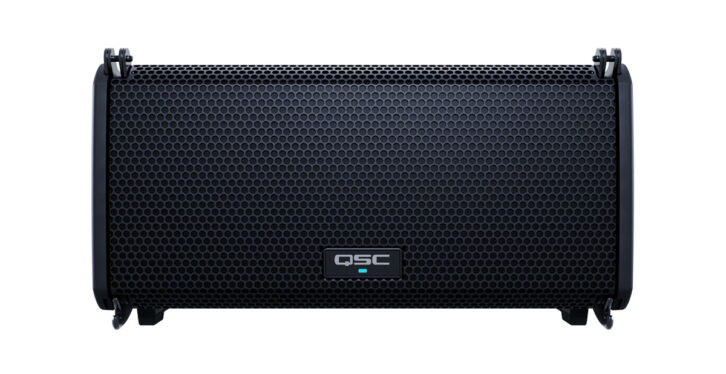 Smaller, powered arrays have found a great market niche and the 8in. two-way QSC LA108 shows why. Its versatility enables it to be used in very complex, high-tech control applications as well as plug-and-play portable scenarios. Deployment is greatly simplified by the daisy-chain connections for analog, digital audio and AC power. The 8in. woofer handles a peak SPL of 134dB generated by the internal 300 W peak power Class D amplifier module. This model can produce long throw characteristics and smooth coverage at 100 degrees horizontal and 15 degrees vertical dispersion.
Smaller, powered arrays have found a great market niche and the 8in. two-way QSC LA108 shows why. Its versatility enables it to be used in very complex, high-tech control applications as well as plug-and-play portable scenarios. Deployment is greatly simplified by the daisy-chain connections for analog, digital audio and AC power. The 8in. woofer handles a peak SPL of 134dB generated by the internal 300 W peak power Class D amplifier module. This model can produce long throw characteristics and smooth coverage at 100 degrees horizontal and 15 degrees vertical dispersion.
 Twin 8in. woofers and the ND640 2in. compression driver turn the 700 Watt RMS two-way digital Class D amplifier of the RCF HDL 10-A active array module into punching sound power. 133dB maximum SPL and a frequency response of 65Hz to 20kHz get full audio into a 15-degree vertical coverage angle with 100 degrees of horizontal spread. The processor section has thermal, RMS, and limiter protection along with operator EQ control. Each of these has its own LED indicator on the rear panel and the DSP includes selectable presets. All of these components are solidly mounted in a composite polypropylene enclosure with wood reinforcement.
Twin 8in. woofers and the ND640 2in. compression driver turn the 700 Watt RMS two-way digital Class D amplifier of the RCF HDL 10-A active array module into punching sound power. 133dB maximum SPL and a frequency response of 65Hz to 20kHz get full audio into a 15-degree vertical coverage angle with 100 degrees of horizontal spread. The processor section has thermal, RMS, and limiter protection along with operator EQ control. Each of these has its own LED indicator on the rear panel and the DSP includes selectable presets. All of these components are solidly mounted in a composite polypropylene enclosure with wood reinforcement.
 There is a wide range of possibilities and applications with the Renkus-Heinz PN102LA Series including external and onboard powering, bi-amping, dual 1in. Mylar HF drivers, and twin 10in. woofers. The self-powered variants feature more exacting control and signal distribution through the RHAON II Renkus-Heinz Audio Operations Network. The company’s SA Series amplifiers such as the SA1250-RD have full networking for control, monitoring, and integral DSP through analog, Dante, or AES/EBU connections. Protection, crossovers, and parametric EQ are all in the signal path for extensive system customization, control and 60Hz to 18kHz frequency response.
There is a wide range of possibilities and applications with the Renkus-Heinz PN102LA Series including external and onboard powering, bi-amping, dual 1in. Mylar HF drivers, and twin 10in. woofers. The self-powered variants feature more exacting control and signal distribution through the RHAON II Renkus-Heinz Audio Operations Network. The company’s SA Series amplifiers such as the SA1250-RD have full networking for control, monitoring, and integral DSP through analog, Dante, or AES/EBU connections. Protection, crossovers, and parametric EQ are all in the signal path for extensive system customization, control and 60Hz to 18kHz frequency response.
 For crafted output in smaller spaces, the two-way TOA Electronics SR-A12S line array speaker provides coverage of 15 degrees vertical and 90 degrees horizontal. Its LF section can handle 450W continuous program power while the HF section works with up to 180W continuous program power. There are two 1.73in. diameter titanium diaphragm compression drivers and the LF uses a single direct-radiating 12in. transducer with a 2.84in. edgewound copper-clad aluminum ribbon voice-coil. The components are installed in a plywood enclosure and finished with black urethane paint. The speaker grille is punched steel finished in black acrylic paint.
For crafted output in smaller spaces, the two-way TOA Electronics SR-A12S line array speaker provides coverage of 15 degrees vertical and 90 degrees horizontal. Its LF section can handle 450W continuous program power while the HF section works with up to 180W continuous program power. There are two 1.73in. diameter titanium diaphragm compression drivers and the LF uses a single direct-radiating 12in. transducer with a 2.84in. edgewound copper-clad aluminum ribbon voice-coil. The components are installed in a plywood enclosure and finished with black urethane paint. The speaker grille is punched steel finished in black acrylic paint.
 The VUE Audiotechnik al-4 subcompact line array system is based around twin 4in. LF drivers with Kevlar cones, isobutylene isoprene rubber surrounds, and neodymium magnets. The HF is handled by a single Pure Truextent beryllium diaphragm compression driver. Up to 24 al-4 elements can be flown from a single fly-bar with only 19lbs. weight per unit. For deeper bass response below 90Hz, the al-4 can be flown with the al-4SB isobaric subwoofer. Power is supplied by the V4 Systems Engine, a two-input, four-output amplifier capable of bi-amping as many as eight al-4 elements. Each al-4 has a -6dB horizontal coverage angle of 90 degrees and a vertical angle of 10 degrees.
The VUE Audiotechnik al-4 subcompact line array system is based around twin 4in. LF drivers with Kevlar cones, isobutylene isoprene rubber surrounds, and neodymium magnets. The HF is handled by a single Pure Truextent beryllium diaphragm compression driver. Up to 24 al-4 elements can be flown from a single fly-bar with only 19lbs. weight per unit. For deeper bass response below 90Hz, the al-4 can be flown with the al-4SB isobaric subwoofer. Power is supplied by the V4 Systems Engine, a two-input, four-output amplifier capable of bi-amping as many as eight al-4 elements. Each al-4 has a -6dB horizontal coverage angle of 90 degrees and a vertical angle of 10 degrees.
 Dante audio leads the way for the Yamaha VXL Series Model P PoE-powered speaker system where the VXL1W-16P (white finish) and VXL1B16P (black finish) output the sound through 16 1.5in. full-range speaker units with neodymium magnets. Not limited to just black or white however, the columns can be painted and wall mounting brackets are included. The Dante network and PoE power are run from a PoE-compliant L2 switch and connected by LAN cabling. Only two inches wide, the speaker column virtually disappears into the room décor. The speaker processing features clip limiting and integral power protection. Nominal horizontal dispersion is 170 degrees with vertical coverage of 30 degrees.
Dante audio leads the way for the Yamaha VXL Series Model P PoE-powered speaker system where the VXL1W-16P (white finish) and VXL1B16P (black finish) output the sound through 16 1.5in. full-range speaker units with neodymium magnets. Not limited to just black or white however, the columns can be painted and wall mounting brackets are included. The Dante network and PoE power are run from a PoE-compliant L2 switch and connected by LAN cabling. Only two inches wide, the speaker column virtually disappears into the room décor. The speaker processing features clip limiting and integral power protection. Nominal horizontal dispersion is 170 degrees with vertical coverage of 30 degrees.
